-
Paper Information
- Previous Paper
- Paper Submission
-
Journal Information
- About This Journal
- Editorial Board
- Current Issue
- Archive
- Author Guidelines
- Contact Us
Electrical and Electronic Engineering
p-ISSN: 2162-9455 e-ISSN: 2162-8459
2013; 3(4): 118-121
doi:10.5923/j.eee.20130304.03
Rectangular Planar Antenna Using U-Slot for Bandwidth Improvement
R. Dakir1, J. Zbitou2, A. Mouhsen1, A. Tribak3, Angel Mediavilla Sanchez4, M. Latrach5
1Laboratoire MMII Faculté des Sciences et Techniques, Settat, Morocco
2Laboratoire LITEN, FST de Settat, Morocco
3Institut national des postes et télécommunications, Rabat, Morocco
4Laboratoire DICOM, Santander, Spain
5RF & Hyper group, ESEO, Angers, France
Correspondence to: J. Zbitou, Laboratoire LITEN, FST de Settat, Morocco.
| Email: |  |
Copyright © 2012 Scientific & Academic Publishing. All Rights Reserved.
This paper presents the design and the achievement of a coplanar compact broadband microstrip antenna. The proposed antenna has a wide matching input impedance with a return loss less than -10dB. This antenna is developed to widen the narrow bandwidth of a microstrip rectangular patch. The antenna structure is designed, optimized and miniaturized by using Momentum software integrated into ADS ”Advanced Design System” and compared with CST Microwave Studio. The final broadband antenna is achieved by using FR4 substrate.
Keywords: Microstrip Antennas (MSA), Wide Band Antennas, Bandwidth Improvement, Narrow Bandwidth
Cite this paper: R. Dakir, J. Zbitou, A. Mouhsen, A. Tribak, Angel Mediavilla Sanchez, M. Latrach, Rectangular Planar Antenna Using U-Slot for Bandwidth Improvement, Electrical and Electronic Engineering, Vol. 3 No. 4, 2013, pp. 118-121. doi: 10.5923/j.eee.20130304.03.
Article Outline
1. Introduction
- Nowadays, with the rapid development of the modern wireless communications technologies (WIMAX: Worldwide Interoperability for Microwave Access, RFID: radio frequency identification, WIFI: Wireless Fidelity), there has been an increasing demand for the development of the broadband antennas. Therefore, the needs of broadband antennas have pushed research efforts to improve and miniaturize the narrow bandwidth antennas. Microstrip antennas are popular for their attractive futures such as low profile, low height, low cost, easy fabrication. On the contrary, the major disadvantage of these types of antennas is the lower and narrow bandwidth[1-5].Combination of the coplanar waveguide feed, antenna geometry, and a variety of slot shapes is a solution to improve and enlarge the antenna operating bandwidth[6-8]. Many configurations have been studied such as Coplanar Waveguide (CPW) feed slot antenna[9-12], in which bandwidth enhancement techniques for microstrip antennas were extensively investigated[13-21]. In this paper, a new low cost broadband coplanar antenna is designed and achieved by using slot techniques. Due to the nature of the feed line that is CPW one, the achieved antenna is suitable for integration with passive and active components.
2. The Conception of Broadband Microstrip Antenna
2.1. Design Procedures
- Firstly, the aim of this study is to improve the bandwidth of the rectangular patch antenna presented in figure.1. Secondly, the final antenna structure should be compact and easy to be integrated with microstrip circuits’ components. To start the design, series of optimizations is conducted by using electromagnetic simulations.
 | Figure 1. Microstrip rectangular patch antenna |
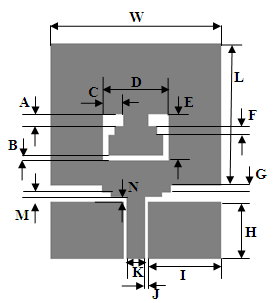 | Figure 2. The Geometry of the proposed antenna |
|
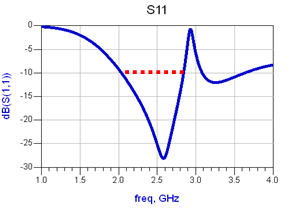 | Figure 3. The return loss versus frequency in GHz |
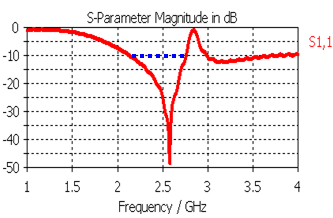 | Figure 4. Return Loss versus frequency on CST |
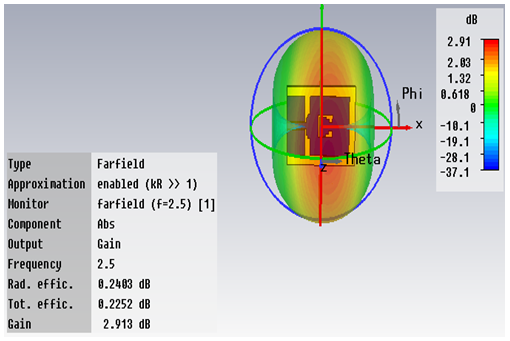 | Figure 5. The 3D radiation pattern of the antenna optimized |
2.2. Achievement & Measurement
- After the comparison of simulation results on ADS and CST, the antenna structure is achieved by using LPKF machine as shown in figure.6.
 | Figure 6. The achieved broadband antenna |
 | Figure 7. Calibration Kit 3.5 mm |
 | Figure 8. Comparison of the simulated and measured return loss versus frequency |
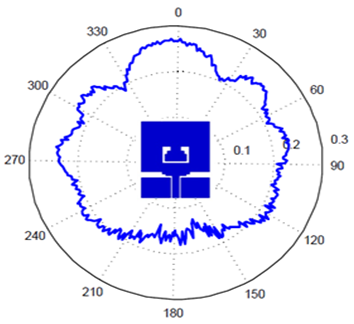 | Figure 9. Radiation pattern @ 2.5 GHz |
3. Conclusions
- In this study, we have performed the conception and the achievement of a new low cost rectangular planar antenna by using slot technique for bandwidth improvement. After many optimizations of the antenna structure, we have validated the antenna structure with a bandwidth of 500MHz. This achieved antenna is feed with CPW line which is easy to integrate it with passive and active printed circuits broad components.
ACKNOWLEDGMENTS
- We fully thank Mr. Angel Mediavilla Sanchez Director of DICOM Laboratory in Santander in Spain and Mr. Mohamed Latrach Professor in ESEO France, for allowing us to use and perform simulations by using softwares and measurement on the VNA, LPKF machine and Anechoic chamber.
 Abstract
Abstract Reference
Reference Full-Text PDF
Full-Text PDF Full-text HTML
Full-text HTML